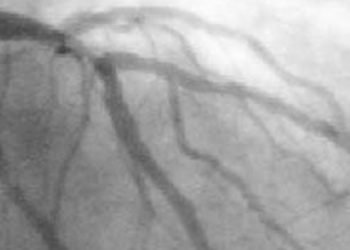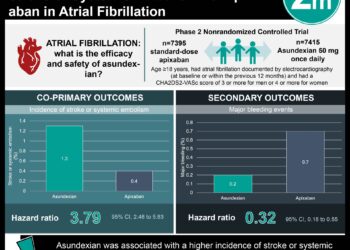Microaxial flow pump improves infarct-related cardiogenic shock outcomes
1. In this randomized controlled trial, in patients with infarct-relate cardiogenic shock, death from any cause was lower in the group that received the microaxial flow pump compared to the group that received the standard care.
2. The composite safety endpoint occurred in more patients in the microaxial flow pump group than in the standard care group.
Evidence Rating Level: 1 (Excellent)
Study Rundown: One possible severe complication of ST-segment elevation myocardial infarction (STEMI) is cardiogenic shock, which is associated with a high risk of mortality. Cardiogenic shock develops when the cardiac output is too low to meet the body’s metabolic needs; thus, prevention would indicate restoring adequate perfusion. One method used in past studies is the percutaneous microaxial flow pump, a type of active mechanical circulatory support system. However, it is unknown whether using this routinely would be of benefit or harm to patients with STEMI-associated cardiogenic shock. To assess the efficacy of this system in treating cardiogenic shock in patients with STEMI, a randomized trial was conducted comparing it to standard care. The eligible participants were randomized using a web-based randomization system based on the timing relative to the revascularization procedure and location of STEMI (anterior or nonanterior). Death due to any cause at 180 days was the main endpoint, while the secondary endpoints were days alive and spent out of the hospital, treatment escalation to additional mechanical circulatory support, heart transplantation, or death from any cause. The limitations of the study were the strict inclusion criteria and lack of race data, which limited generalizability. Overall, the study found that treating patients with STEMI-related cardiogenic shock with a microaxial flow pump led to a lower risk of death compared to standard care at 180 days. However, the risk of adverse events was higher in the intervention group.
Click here to read the study in NEJM
In-Depth [randomized controlled trial]: This randomized control trial assessed the impact of a microaxial flow pump on the recovery of STEMI patients with cardiogenic shock. If patients were 18 years or older and had STEMI and cardiogenic shock, they were eligible to participate. Cardiogenic shock was defined as hypotension, insufficient perfusion to end organs, an arterial lactate level of 2.5 mmol per liter or higher, and a left ventricular ejection fraction of less than 45%. Participants were excluded if they had right ventricular failure or were resuscitated for an out-of-hospital cardiac arrest and were comatose on hospital arrival. After screening and obtaining consent, 355 patients were randomized into the microaxial flow pump group (n=179) or the standard-care group (n=176). In the microaxial flow-pump group, death from any cause resulted in 82 of the 179 participants (45.8%), whereas in the standard care group, death resulted in 103 of 176 participants (58.5%) (hazard ratio, 0.74; 95% Confidence Interval [CI], 0.55 to 0.99; p=0.04). When comparing adverse events between the two groups, the microaxial-flow-pump group had a composite safety end-point event occurred in 43 patients (24.0%), whereas the standard-care group had this endpoint in 11 (6.2%) of patients (relative risk, 4.74; 95% CI, 2.36 to 9.55). The relative risk was also compared between the two groups. It was 2.06 (95% CI, 1.15 to 3.66) for moderate or severe bleeding, 5.15 (95% CI, 1.11 to 23.84) for limb ischemia, 1.98 (95% CI, 1.27 to 3.09) for renal-replacement therapy, and 2.79 (95% CI, 1.20 to 6.48) for sepsis with a positive blood culture. In summary, microaxial flow pump use resulted in lower mortality in STEMI-related cardiogenic shock patients as compared to standard care.
Image: PD
©2024 2 Minute Medicine, Inc. All rights reserved. No works may be reproduced without expressed written consent from 2 Minute Medicine, Inc. Inquire about licensing here. No article should be construed as medical advice and is not intended as such by the authors or by 2 Minute Medicine, Inc.







